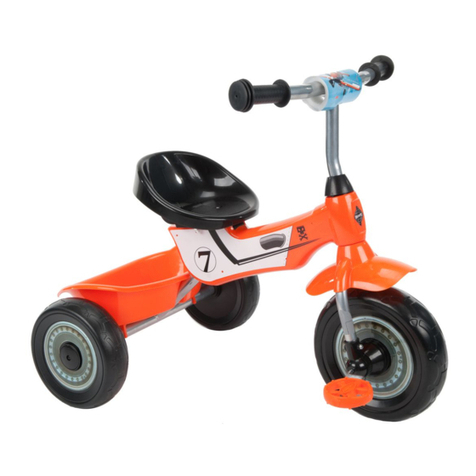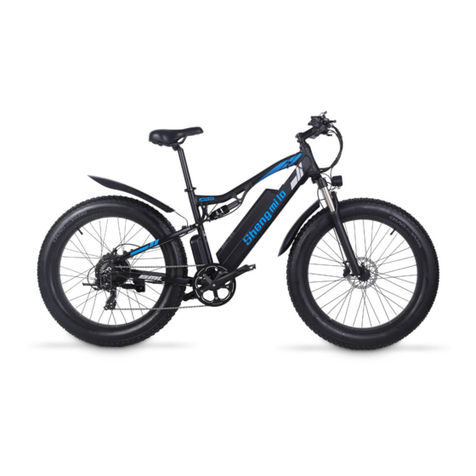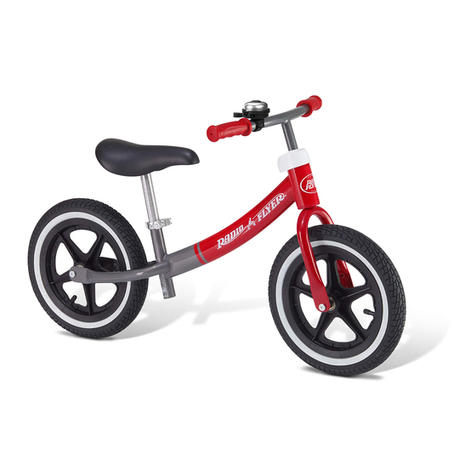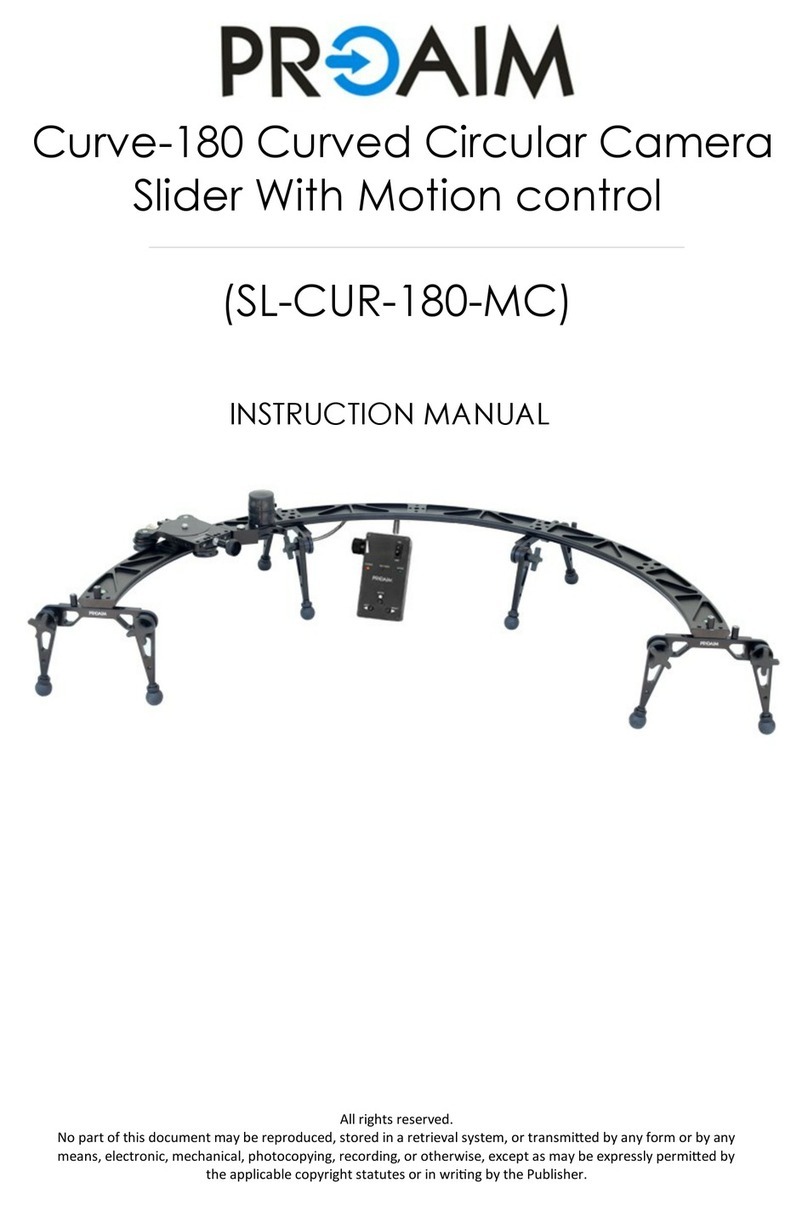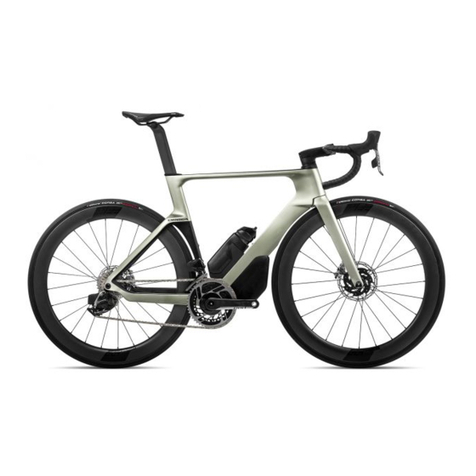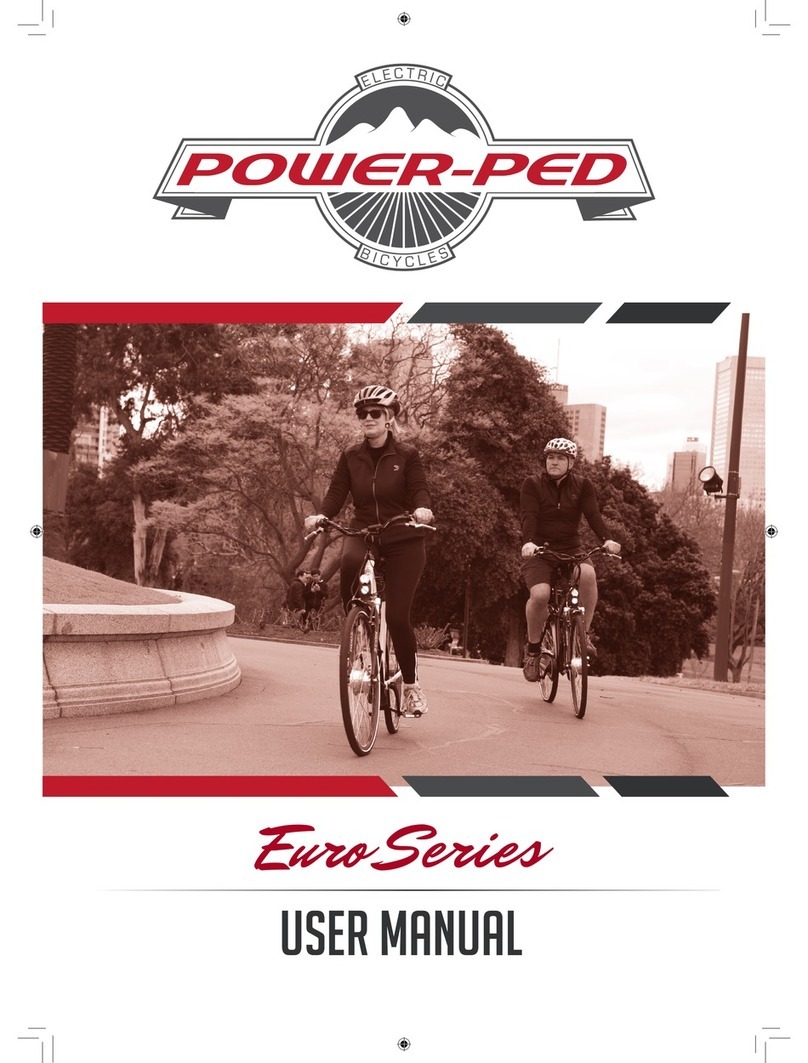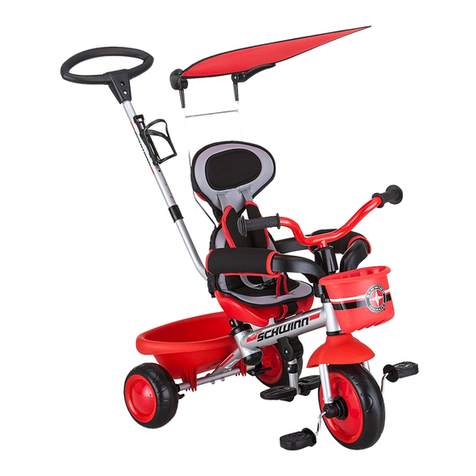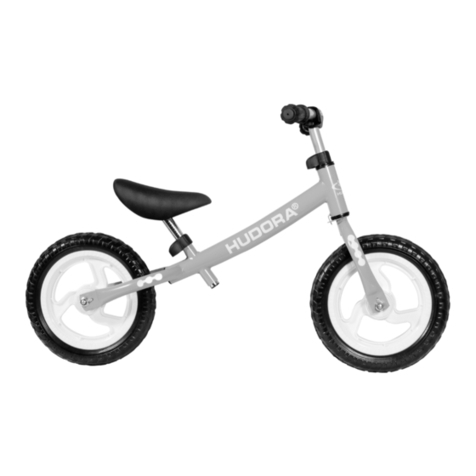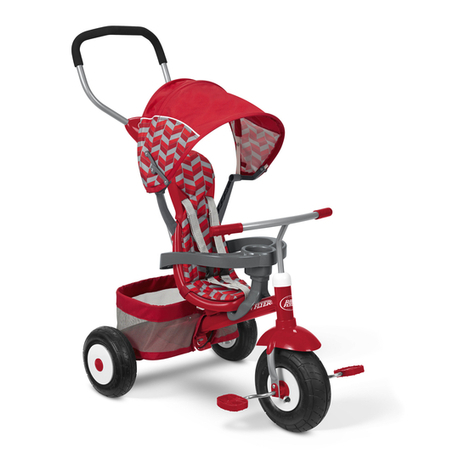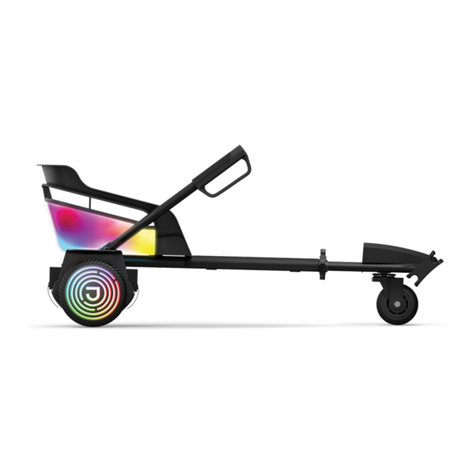AERO-SERVICE EV4 QUAD User manual

VERSION 1.00
EV4 BIKE
AERO-SERVICE Jacek Skopiński
Dereniowa 4/69
02-776 Warsaw
POLAND
OWNERS
MANUAL

MANUAL
EV 4 BIKE
2017-07-24 VERSION 1.00 Page 2of 26
Index
1. PRELIMINARY INFORMATION................................................................................................... 4
1.1. Content and addressees of this manual..............................................................................................................................4
1.2. Symbols..............................................................................................................................................................................4
1.3. Cooperation with the user of EV4......................................................................................................................................4
1.4. Compliance with safety requirements................................................................................................................................5
2. Vehicle description............................................................................................................................. 6
2.1. Manufacturer contact details:............................................................................................................................................6
2.2. General description ...........................................................................................................................................................6
3. Proper use......................................................................................................................................... 10
4. Warnings for unauthorised use....................................................................................................... 10
5. Residual risk..................................................................................................................................... 11
6. Technical information..................................................................................................................... 11
7. Putting to use.................................................................................................................................... 12
7.1. Minimal requirements for vehicle operation....................................................................................................................12
7.2. Before use ........................................................................................................................................................................12
8. Operator requirements..................................................................................................................... 12
9. Use of Personal Protective Equipment............................................................................................ 13
10. Use.................................................................................................................................................... 13
10.1. How to operate the EV4...............................................................................................................................................13
10.2. Essential activities during use of EV4 BIKE................................................................................................................14
10.3. Display description......................................................................................................................................................16
10.4. Charging and fuse description.....................................................................................................................................18
11. Setup................................................................................................................................................. 20
11.1. Seat height....................................................................................................................................................................20
11.2. Braking system.............................................................................................................................................................20
11.3. Shock absorbers...........................................................................................................................................................20
12. Maintenance..................................................................................................................................... 21
12.1. Wheels..........................................................................................................................................................................21
12.2. Bolts and glued parts. ..................................................................................................................................................22
12.3. Vehicle transmission....................................................................................................................................................22
12.4. Lubrication...................................................................................................................................................................22
13. Fixing ............................................................................................................................................... 23
14. Moving EV4 ..................................................................................................................................... 23
15. Part specification ............................................................................................................................. 23

MANUAL
EV 4 BIKE
2017-07-24 VERSION 1.00 Page 3of 26
16. Noise................................................................................................................................................. 23
17. Radiation.......................................................................................................................................... 23
18. Troubleshooting............................................................................................................................... 24
19. Declaration of conformity................................................................................................................ 24
Warning! Please read this manual before first use and observe safety regulations first. To ensure proper operation of the
vehicle for a long time, follow the maintenance instructions carefully.
If you are left with any questions after reading this manual, AERO-SERVICE will gladly answer them.

MANUAL
EV 4 BIKE
2017-07-24 VERSION 1.00 Page 4of 26
1. PRELIMINARY INFORMATION
1.1. Content and addressees of this manual
This technical publication is a manual for EV4 BIKE manufactured by AERO-SERVICE.
The manual refers to „main application of the device”, together with all the technical information about
exploitation, assembly and maintenance of the device. This manual is addressed to all users of the EV4 BIKE.
In case of loss or a case where it will no longer be usable it is recommended to order a copy of the manual from the
producer.
The manufacturer reserves the right to these materials and intellectual property rights and prohibits,
even in part, copying and/or disclosure of the content of the documentation without the
manufacturer's permission.
1.2. Symbols
To ensure safety of the users, and to avoid any interference in operation, safety instructions must be followed. These
symbols will help you achieve that:
SYMBOL
MEANING
DESCRIPTION
Danger
This symbol indicates situations of grave danger, neglect of which can
seriously jeopardize the risk of loss of health and safety of persons.
Danger
This symbol indicates serious electrical hazards which may negatively
impact health or even cause death.
Warning
This symbol indicates the need for warning or attention to key functions
or important information.
1.3. Cooperation with the user of EV4
The manual reflects the equipment and the technical condition of the machine at the time of commissioning. Any change
in this manual will result in the shipment of a copy of the manufacturer's new instruction to each customer and such
documentation should be stored with this manual.

MANUAL
EV 4 BIKE
2017-07-24 VERSION 1.00 Page 5of 26
1.4. Compliance with safety requirements
AERO-SERVICE declares with all responsibility, that the product is compliant with following standards:
PN-EN ISO - 12100:2012 Safety of machines -- General design principles -- Risk assessment and risk
reduction.
EV4 BIKE meets the requirements of the following European Directives:
The Directive 2006/42/EC of the European Parliament and of the Council of 17 May 2006 concerning
machinery and certain parts of machinery.
Directive 2014/30/EU of the European Parliament and of the Council of 26 February 2014 on the
harmonisation of the laws of the Member States relating to electromagnetic compatibility.
The devices have been CE marked and have been issued a declaration of conformity for them - due to the
requirements set out in the above directives.
Nameplate attached to the device:

MANUAL
EV 4 BIKE
2017-07-24 VERSION 1.00 Page 6of 26
2. Vehicle description
2.1. Manufacturer contact details:
AERO-SERVICE Jacek Skopiński
Dereniowa 4/69
02-776 Warsaw, Poland
Tel. +48 603 397 810
e-mail. ev4@ev4.pl
2.2. General description
The vehicle has an adaptive suspension that adapts to the shape or inclination of the terrain and allows the vehicle to
tilt in the bend so as to eliminate the effect of the centrifugal force. The vehicle is used to transport people.
Diag. 1 EV4 BIKE

MANUAL
EV 4 BIKE
2017-07-24 VERSION 1.00 Page 7of 26
Diag. 2 MAIN PARTS
HANDLEBAR
FRONT
WHEELS
PEDALS
IGNITION
FRAME
SEAT
REAR
BASKET

MANUAL
EV 4 BIKE
2017-07-24 VERSION 1.00 Page 8of 26
Diag. 3 MAIN PARTS
Diag. 4 MAIN PARTS
SWINGARMS
LINKS AND
PUSHERS OF
STEERING
CONTROL
BRAKE
PIPES
FRONT
WHEELS
BRAKE
CALIPER
BRAKE DISC
BATTERY
CASING
FRONT SHOCK
ABSORBER
SHIFTER
STEERING
KNUCKLE
BRAKE DISC
LINKS AND PUSHERS OF
STEERING CONTROL
BRAKE CALIPER

MANUAL
EV 4 BIKE
2017-07-24 VERSION 1.00 Page 9of 26
Diag. 5 MAIN PARTS
Diag. 6 MAIN PARTS
HANDLEBAR
REAR WHEEL
BRAKE CALIPER
BRAKE DISC
SHIFTER
FRAME
TURNING
MECHANISM
PEDAL
CHAIN
REAR SHOCK
ABSORBER
REAR
SWINGARM
CHARGING
OUTLET
FRAME
PEDAL
REAR WHEEL
TURNING
MECHANISM
KICKSTAND

MANUAL
EV 4 BIKE
2017-07-24 VERSION 1.00 Page 10 of 26
3. Proper use
The vehicle can only be used to transport people over 18 years of age. The weight of the person and the
baggage must not exceed 100 kg. The luggage compartment is designed to carry luggage of a maximum
weight of 8 kg.
WARNING! It is forbidden to use the vehicle contrary to its purpose.
Use for other purposes is not allowed. Proper use also includes all activities related to the correct and safe
operation and maintenance of the EV4. Accordingly, the user is obliged to:
read the manual and adhere to its recommendations and warnings;
understand how the machine operates and maintain safety;
avoid accidents.
4. Warnings for unauthorised use
WARNING! The manufacturer is not responsible for the consequences of improper use.
EV4 BIKE is a power assisted bicycle with power up to 250 W and speeds up to 25 km/h. You can travel on public
roads, except for highways, expressways and banned places. If in doubt, please contact us.
Incorrect use of EV4 may cause personal injury. Use protective clothing such as suitable footwear, gloves, helmet,
knee pads, elbow pads, safety goggles, etc.
Do not use the product on: unhardened, wet, slippery and uneven surfaces.
It is forbidden to drive under the influence of alcohol, intoxicants, narcotics, and drugs which don’t allow driving
vehicles.
EV4 is an electric vehicle, so it is not allowed to use it in the rain or in humid conditions. The vehicle cannot be
driven into puddles.
It is prohibited to: pour water onto EV4, keeping and using it in rain, washing and cleaning under running water.
Removing dirt is possible using a damp cloth.
This product is only for users over the age of 18.
Persons using the vehicle must have the ability to maintain balance while driving as they would on a two-wheeled
vehicle such as a bicycle, scooter or motorbike. They should also have the appropriate height so that when using the
vehicle they can support their foot during the stop. They must be people who have good eyesight, reflexes, and are
able to make quick decisions.

MANUAL
EV 4 BIKE
2017-07-24 VERSION 1.00 Page 11 of 26
The vehicle owner is fully responsible for any damages resulting from the use of the EV4
EV4 is not designed for extreme driving. It is forbidden to perform jumps and other dangerous evolutions. You
cannot speed it up and stop too fast.
Speed must be adapted to field conditions. Longer braking distances should be considered for slippery surfaces.
Overload: do not overload the vehicle's power package and overload the vehicle itself. The weight of the driver along
with the luggage must not exceed 100 kg. Overload and excessive load can damage the vehicle and the power unit.
Driving at the same time is only permitted by one person. Driving in two or more is prohibited.
Before each use of the vehicle, the driver is obliged to inspect the technical condition of the vehicle. Make sure all
components are in place, no screws and nuts missing. Check the front and rear brakes.
5. Residual risk
Residual risk is risk that still remains after all precautions have been taken.
When observing such recommendations as:
read the manual carefully;
do not place hands in between moving parts ;
do not make any modification or repairs to the electrical parts of the vehicle;
do not operate the vehicle without reading the manual first,
secure the EV4 from persons unauthorized to operate it,
Residual risk can be eliminated without endangering people and the environment. There is a residual risk in case of
non-compliance with the specified recommendations and guidelines.
6. Technical information
Main technical information is shown in the table below.
TECHNICAL INFORMATION
INPUT VOLTAGE
230 V
OUTPUT VOLTAGE
37 V
FREQUENCY
50-60 Hz
MAXIMUM POWER OUTPUT
250 W
WEIGHT
35 KG

MANUAL
EV 4 BIKE
2017-07-24 VERSION 1.00 Page 12 of 26
7. Putting to use
7.1. Minimal requirements for vehicle operation
EV4 is an electric vehicle so it is not allowed to use it in the rain or in high humidity conditions. The vehicle cannot
be driven into puddles.
It is prohibited to pour water onto it, keep and use it in rain, wash and clean under running water. Storage and use
temperatures must be between +1 and +40 degrees Celsius.
7.2. Before use
Take special care when starting up the machine; check all safety and security functions. Remember to read this
manual carefully and first observe safety regulations.
Check before use:
Tire pressure,
Shock absorber pressure.
Battery charge.
Transmission belt tension
Check for suspension malfunctions.
Check for steering control malfunctions.
Check for brake system malfunctions.
8. Operator requirements
The person selected and authorized to operate and maintain EV4 must have the appropriate knowledge. Service work may
only be performed by persons who have manual skills and are familiar with the operating instructions. To properly handle EV4
the user must:
Know how to use and seek information in this document;
Know how the EV4 functions;
Have a medical condition consistent with the certificate given by a physician,
Have at least 18 years of age;

MANUAL
EV 4 BIKE
2017-07-24 VERSION 1.00 Page 13 of 26
Be mentally and physically fit;
The person selected and authorized to operate and maintain EV4 must have the appropriate knowledge.
The weight of the driver with the luggage must not exceed 100 kg. Overloading can damage the vehicle and drive
train.
Recognize abnormalities in functioning and, if necessary, take necessary measures to remove them.
Persons using the vehicle must have the ability to maintain balance while driving as they would on a two-wheeled
vehicle such as a bicycle, scooter or motorbike. They should also have the appropriate height so that when using the
vehicle they can support their foot during the stop. They must be people who have good eyesight, reflexes, and can
make quick decisions.
9. Use of Personal Protective Equipment
To avoid injury when using EV4, wear protective equipment. Equipment includes bicycle helmet, knee and elbow
pads. Protective gloves are recommended during repairs and maintenance.
10. Use
10.1. How to operate the EV4
When driving on the EV4 BIKE, sit on the seat; hold your hands on the steering wheel, feet when stopped on the
ground and while driving on pedals. Keep your hands and feet away from all the mechanical components of the vehicle such as
steering suspension or drive system. Do not touch: vehicle mechanisms drive system and vehicle suspension during operation.
Before using the EV4 BIKE for the first time, charge the battery to 100%.
You should push your foot slightly off the ground while pressing down with the other foot on the pedal. You need to
move from 1st gear. When you start pedalling, the engine starts to assist if the ASSIST level is greater than 0. As the speed
increases, you can change gears to higher if the terrain allows it. Shift upwards by pressing the blue derailleur button and down
with the black derailleur lever. Both activities are done with the thumb of your right hand. You can change the power of the
push button up or down on the control panel while driving. The equilibrium should be kept in the same way as in two-wheeled
vehicles. Twisting is done by simultaneous body balance and steering turn. The vehicle stops after the pedalling has been
stopped and the right and left levers of the brake are pressed simultaneously, ensuring that the wheels are not locked. This may
cause loss of steer ability, balance and tipping. When stopping in the final phase, you should support with your foot.
The maximum tilting of the vehicle while making a turn is 30 degrees. Increasing the tilting of the vehicle beyond 30
degrees may cause the suspension to fall against the limiter and consequently damage the vehicle and lead to imbalance.

MANUAL
EV 4 BIKE
2017-07-24 VERSION 1.00 Page 14 of 26
Diag. 7 THE HANDLEBAR
10.2. Essential activities during use of EV4 BIKE
1. Put the vehicle in vertical position
2. Fold the kickstand
3. Put the ignition key in and turn to the
right (power will be supplied to the
USB port and the driving aid
controller)
4. Sit on the seat and put your hands on
the handlebar
5. Press and hold for 2 sec. the middle
button on the driving aid control panel
6. After the computer has been turned on
one can turn on the panel backlight if
needed by pressing and holding the top
button for 2 sec.
DRIVE AID
STEERING
PANEL
USB
PORT
BELL
COMPUTER
SHIFTER
FRONT
BRAKE
LEVER
REAR
BRAKE
LEVER
IGNITION

MANUAL
EV 4 BIKE
2017-07-24 VERSION 1.00 Page 15 of 26
7. In the lower left corner of the screen,
the ASSIST field displays the current
power of support. Adjustment is made
by pressing the upper or lower button
on the control panel. The number 0 to
5 will be displayed (0 means no power
and 5 is the maximum power)
8. After selecting the required power,
start driving by pressing on the pedals
(the engine will start to power up after
about 1 second when it receives a
signal from the crankshaft sensor).
9. When driving, you can change the
power of the aid with buttons (upper
and lower) as needed, and adjust to the
pitch of the ground by changing the
gear lever
10. The driving computer is equipped with
the ability to start the engine without
having to pedal. To start this function,
hold for about 2 sec. The bottom
button on the control panel. The engine
will start but the vehicle speed will be
limited to 6 km/h.
11. After driving, turn off the vehicle with
a key and secure it against unwanted
use, children, etc. Leave the vehicle in
a tilted condition and prevent it from
rolling downhill.

MANUAL
EV 4 BIKE
2017-07-24 VERSION 1.00 Page 16 of 26
10.3. Display description
Diag. 8 COMPUTER CONTROL BUTTONS
Diag. 9 COMPUTER DISPLAY

MANUAL
EV 4 BIKE
2017-07-24 VERSION 1.00 Page 17 of 26
1
UP
10
PUSH ASSIST
2
ON BUTTON / ACCEPT
11
SPEED IN KILOMETERS PER
HOUR
SPEED IN MILES PER HOUR
MAXIMAL SPEED
AVERAGE SPEED
3
DOWN
12
DISTANCE IN KILOMETERS
DISTANCE IN MILES
DISTANCE OF ONE TRIP
TOTAL DISTANCE TRAVELED
BATTERY VOLTAGE
4
BATTERY CHARGE
INDICATOR
13
LEVEL OF ASSIST
CRUISE CONTROL
5
LIGHTS
(NOT SUPPORTED)
6
BRAKE
(NOT SUPPORTED)
7
DAYLY TIME
TRAVELED
TOTAL TIME
TRAVELED
8
MOTOR POWER
MOTOR
TEMPERATURE IN
DEGREES CELSIUS
MOTOR
TEMPERATURE IN
DEGREES
FAHRENHEIT
9
SURROUNDING
TEMPERATURE
SURROUNDING
TEMPERATURE
Table. Screen and panel description

MANUAL
EV 4 BIKE
2017-07-24 VERSION 1.00 Page 18 of 26
10.4. Charging and fuse description
EV4 BIKE is supplied with a Li-Ion 37V, 14Ah battery. In order to properly charge the battery, use the charger
supplied with the vehicle. You will need a special 37 V charger for Li-ion batteries. It is forbidden to use a charger other than
the original charger. Using a charger other than the original charger may result in electrical damage, short circuit, fire and
personal injury. It may also cause permanent damage to the battery and the vehicle's electrical system.
The charger must first be connected to the vehicle then to the network. Charging socket is on the right side of the
frame at the rear. Take the lid off the socket and then plug in the charger plug.
The charger must be disconnected from the vehicle when the vehicle is fully charged (charge will not occur after
100%). It is indicated with a green lamp on the charger. Secure the vehicle's charging socket when charging is complete. After
the charge is complete, one can start the vehicle with the key. Disconnect the charger before starting the vehicle. Do not
connect any equipment or short connectors to the charger socket. The charger for the EV4 does not charge other batteries.
EV4 vehicles have fuses for electrical wiring. Fuses are located on the battery casing. If the vehicle cannot be started
or the battery won’t recharge check whether the fuse has been blown. For this purpose dismantle the frame cover with the
screws and check the fuse in the battery. Locating the cover and fuse holder bolts is shown in the photographs.
If the vehicle cannot be started and the fuse is working, contact the manufacturer / service. Do not perform repairs on
your own. The EV4 BIKE uses a 30A main fuse. When it is necessary to replace the fuse, it is necessary to use a new one with
the same current.
It is forbidden to use a fuse of other parameters. This may cause damage to the electrical system and fire.
Diag. 10 BATTERY COVER BOLTS
COVER
BOLTS

MANUAL
EV 4 BIKE
2017-07-24 VERSION 1.00 Page 19 of 26
Diag. 11 LOCATION OF THE FUSE
Diag. 12 CHARGING SOCKET
FUSE
CHARGING
SOCKET

MANUAL
EV 4 BIKE
2017-07-24 VERSION 1.00 Page 20 of 26
11. Setup
11.1. Seat height
The seat is equipped with a bicycle seat tube with variable height adjustment. Loosen the pipe clamp to change the
height. After fixing the height again tighten the fixing. Pay attention to the proper crimping force of the tube. Insufficient force
of clamp may cause the seat to fall while driving. This situation is dangerous for the driver.
11.2. Braking system
The brake system has two independent front and rear brake circuits. The front wheels stop using the right lever and
the rear wheels stop using the left lever. The braking system is very effective, so excessive use of the brake lever can cause the
wheel to block and consequently you may fall into a slippage and lose balance. Operate the brake lever with your index finger
and middle finger instead of your whole hand. Front wheel locking may cause lack of front steering and cause the vehicle to tip
over. Before going full speed, one must practice using the brakes to properly control the vehicle, If squeaking occurs during
braking, it has become uneven in individual wheels, brakes have become ineffective, or other disturbing braking problems are
observed immediately replace the brake pads.
11.3. Shock absorbers
The hardness of the shock absorbers should be adjusted to the weight of the driver. Excessive deflection of the shock
absorber can cause damage to the vehicle and damper and cause discomfort to the driver. The shock absorber must be set as
follows: The person who will drive the vehicle must sit on the vehicle with both feet on the ground. The second person at the
same time should check the damper's initial deflection, which should be about half of total stroke. For DT SWISS shock
absorbers with a length of 190 mm the total deflection is 50 mm and the initial deflection (when the driver sits on the vehicle)
in the front and rear shock absorbers should be 25 mm. Adjustment of hardness is done by pumping the shock absorber with a
pump and dropping pressure is done by venting the valve. Approximate pressure in the front shock absorber is 2-3 bars while
in the rear 4-6 bar. Maximum pressure cannot exceed 18 bars. Exceeding this pressure can damage the shock absorber.
Damper adjustment should be unscrewed towards the softest damping. The shock absorber should be set to: unlocked.
Diag. 13 SHOCK ABSORBER CONFIGURATION
SOFT
DAMPING
REGULATOR
STIFF
Other manuals for EV4 QUAD
1
Table of contents
